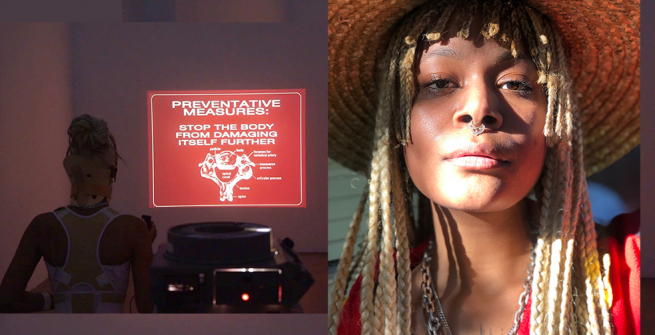Panteha Abareshi is an L.A. based artist whose work hones in on chronic illness and disability. Abareshi lives in a body that coexists with sickle cell zero beta thalassemia and their performance-based work reflects the complexities that come with experiencing a body with chronic illness. Abareshi currently has a solo exhibition, Tender Calamities, at the Los Angeles Municipal Art gallery.
How would you describe your work?
My practice is rooted in my existence within a chronically ill (sick)//disabled body, and I work in converging forms of media to embody and examine the immensely nuanced, overwhelming facets of the disabled experience. While I produce work across various mediums, performance lies at the crux of all my pieces. There is a cyclical and ever-morphing examination, documentation, and dissection of my own Body, but as my practice has developed, my Body has shifted from subject to material within my work.
I am drawn to creating performance-for-video works involving strenuous and exhausting body-work, where I push myself to, and often beyond, the limits of my physical capabilities. This is both a means of exercising futile control over a rapidly deteriorating body and cathartic acknowledgment of my increasing “inability” as my condition worsens.
My sculptural works hone in on the notion of disembodiment, and the imaging of the sick/disabled body as a fundamental object - aestheticized and malleable under the Able-bodied and medicalized gaze. The radicalized objectification of my own corporeal form allows for a continued examination of the body-politics around the sick/disabled body, and its connection to a larger context of universal fragility fear, pain, and mortality.
How did you get started on your artistic journey and when did your work begin to focus on disability and chronic illness?
I began my artistic practice in my early teenage years, as a coping mechanism during a time in which I was experiencing a sudden and intense worsening of my condition. While my work was very different than what I produce now, it was nevertheless still focused on illness and disability. There has never been a moment where the work I am making does not in some way return to the overwhelming complexities of illness/disability that occupy my thoughts.
How has the pandemic affected your ability to create?
While the pandemic was a sudden shock, and quite life-altering to the able-bodied population, it was much less of a change for me. I was isolated in hospital and bed-ridden due to immobility from my condition when the first lockdown began in Los Angeles. My pre-existing illness and disability cause me to be highly immuno-compromised, and the inability to leave my home (or my bed) for long periods of time has been a reality for me for a great many years. My practice before the pandemic was one that was constantly being adapted to accommodate my inability to be mobile. So, because I was already contending with restrictions and limitations before the pandemic began, I did not feel any immediate impact on my practice. I was transferred to my family home in Arizona in the spring of 2020 to rest after my hospitalization, and the lockdowns made it so I unexpectedly remained there through the entire summer. I did not have access to most of my equipment, or the spaces I use to fabricate work and create performance-for-video pieces, but this ultimately did not preclude me from making new works. In the early months of the pandemic, I struggled emotionally with the response to the pandemic - both the immense irresponsibility by those with able-bodied privilege, but also the ways in which accessibility measures were swiftly put into place as a result of able-bodied need, rather than the pre-existing demand for these measure from the sick/disabled population. This frustration I felt pushed me to a new form of performative practice, that ultimately produced my first artist book I was able to get published at the end of 2020. Certainly, the pandemic affected my ability to create- not by precluding it, simply by coaxing it to continue adapting.
What message do you aim to convey about ableism, disability, chronic illness, and medical violence?
This is quite a large, vast question, and I am unable to distill my work into a singular “message” about ableism, disability, chronic illness, and/or medical violence. It is not my intention within my work to leave the viewer with one concise message or feeling around any of those subjects - to do so would be to limit the ways in which I am pushing myself in my work. My practice is fundamentally driven by my belief that the reasons we are so ill-equipped to face, discuss and understand the complexities of the sick/disabled experience is because we are averse to engaging with what makes us uncomfortable. We are averse to engaging with what is difficult, and with what does not promise a neat, or satisfying conclusion. When I confront ableism in my work, it is not to convey a message of “wrongness,” but rather to illustrate that the ways in which we interact with othered bodies inform larger realities of body-politics. When I confront medical violence within my work, it is as a means of critically examining the Hospital as Institution, the medical-gaze as weapon, and to be critical of notions of “safety,” “health” and definitions of the body which upholds the pillars of ableism. I cannot say what “message” I hope to convey, I can only say what critical modes of thought I hope to create and engage with.
What are some themes you have yet to explore that you would like to take on in the future?
Currently I am examining the erotics of the Illness and disability, focusing on the disabled body as fetish object as a means of confronting my own complicated emotions around the eroticization of my own body. This exploration spurs from my perception of the disabled body as simultaneously unsexed/castrated and hyper-fetishized.
To see Panteha Abareshi's work, visit the virtual exhibit.





